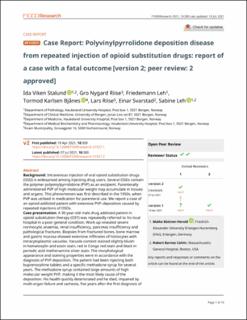| dc.contributor.author | Stalund, Ida Viken | |
| dc.contributor.author | Riise, Gro Nygard | |
| dc.contributor.author | Leh, Friedemann | |
| dc.contributor.author | Bjånes, Tormod Karlsen | |
| dc.contributor.author | Riise, Lars | |
| dc.contributor.author | Svarstad, Einar | |
| dc.contributor.author | Leh, Sabine | |
| dc.date.accessioned | 2021-11-24T10:50:04Z | |
| dc.date.available | 2021-11-24T10:50:04Z | |
| dc.date.created | 2021-07-28T17:05:40Z | |
| dc.date.issued | 2021 | |
| dc.identifier.issn | 2046-1402 | |
| dc.identifier.uri | https://hdl.handle.net/11250/2831256 | |
| dc.description.abstract | Background: Intravenous injection of oral opioid substitution drugs (OSD) is widespread among injecting drug users. Several OSDs contain the polymer polyvinylpyrrolidone (PVP) as an excipient. Parenterally administered PVP of high molecular weight may accumulate in tissues and organs. This phenomenon was first described in the 1950s, when PVP was utilised in medication for parenteral use. We report a case of an opioid-addicted patient with extensive PVP–deposition caused by repeated injections of OSDs.
Case presentation: A 30-year-old male drug addicted patient in opioid substitution therapy (OST) was repeatedly referred to his local hospital in a poor general condition. Work-up revealed severe normocytic anaemia, renal insufficiency, pancreas insufficiency and pathological fractures. Biopsies from fractured bones, bone marrow and gastric mucosa showed extensive infiltrates of histiocytes with intracytoplasmic vacuoles. Vacuole content stained slightly bluish in hematoxylin and eosin stain, red in Congo red stain and black in periodic acid methenamine silver stain. The morphological appearance and staining properties were in accordance with the diagnosis of PVP deposition. The patient had been injecting both buprenorphine tablets and a specific methadone syrup for several years. The methadone syrup contained large amounts of high molecular weight PVP, making it the most likely cause of the deposition. His health quickly deteriorated and he died, impaired by multi-organ failure and cachexia, five years after the first diagnosis of PVP-deposition. The autopsy revealed extensive PVP-deposition in all sampled organs and tissues.
Conclusions: Histological investigation and the correct identification of PVP in the biopsies led to the discovery of a severe adverse effect from long-standing misuse of a drug. The disseminated PVP deposition likely contributed to multi-organ dysfunction and cachexia with a fatal outcome. The deposited PVP likely originated from repeated injections of a certain methadone syrup. | en_US |
| dc.language.iso | eng | en_US |
| dc.publisher | F1000Research | en_US |
| dc.rights | Navngivelse 4.0 Internasjonal | * |
| dc.rights.uri | http://creativecommons.org/licenses/by/4.0/deed.no | * |
| dc.title | Case Report: Polyvinylpyrrolidone deposition disease from repeated injection of opioid substitution drugs: Report of a case with a fatal outcome | en_US |
| dc.type | Journal article | en_US |
| dc.type | Peer reviewed | en_US |
| dc.description.version | publishedVersion | en_US |
| dc.rights.holder | Copyright 2021 the authors | en_US |
| dc.source.articlenumber | 300 | en_US |
| cristin.ispublished | true | |
| cristin.fulltext | original | |
| cristin.qualitycode | 1 | |
| dc.identifier.doi | 10.12688/f1000research.51927.2 | |
| dc.identifier.cristin | 1922905 | |
| dc.source.journal | F1000 Research | en_US |
| dc.identifier.citation | F1000 Research. 2021, 10, 300. | en_US |
| dc.source.volume | 10 | en_US |

